Blueprints: Tabernacle Structure – 26
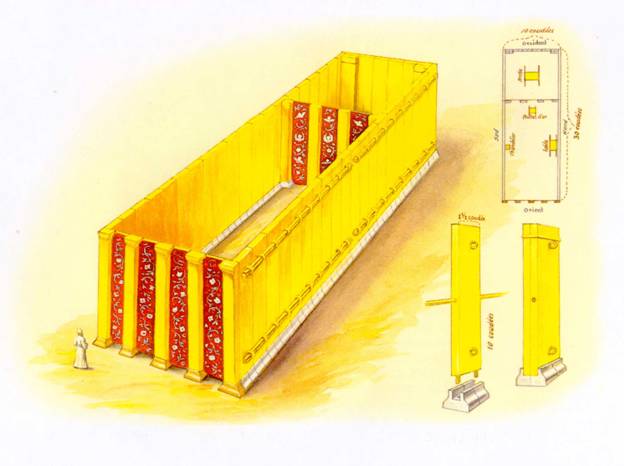
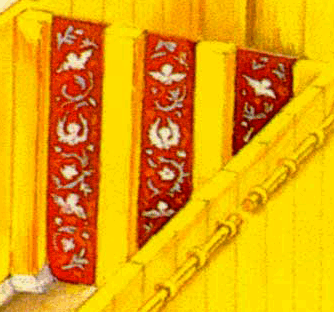 Curtains (3 paragraphs) 26:1-14
Curtains (3 paragraphs) 26:1-14
(Ex. 26:1) “Moreover you shall make the tabernacle with ten curtains of fine twisted linen and blue and purple and scarlet material; you shall make them with cherubim, the work of a skillful workman.
Why make curtains for the tabernacle? What is their purpose? Curtains – yeriyah (יריעה) Strongs #3407 – a curtain or drape, covering. Since the tabernacle is really a tent, these amount to coverings to drape over the tent. They serve multiple purposes: Decoration, protection, a roof & cover, privacy to the inside.
How is the linen described? What are the properties of linen? Fine twisted linen would be an upscale variety of linen. Linen is…
What is the significance of the materials and colors used to make the curtains?
| Color | Biblical Color Symbolism | Details | How its Made… |
| LINEN | righteousness, purity | ||
| BLUE | Heaven | This color is covered in more detail in the section on the high priest’s garments. The color techelet implies, perhaps, a sky blue. | “Blue from shell of fish in the Red Sea.” –Dr. James Modlish |
| PURPLE | Royalty | “Purple from shellfish in the Mediterranean” -Dr. James Modlish | |
| SCARLET | suffering, sacrifice | Think: The sacrifice and death of Christ, the work of the Cross. | “Scarlet was from the bodies of cochineal (insect) baked in ovens” –Dr. James Modlish. “The Word scarlet in Hebrew is the word Tolaith which is translated 2 ways – Scarlet & worm – why? The way that they made scarlet die in those days – they would take the Tolaith worm & grind him up – tip cloth into the Blood – scarlet color” -Pastor Rob Salvato, Calvary Chapel Vista |
What is the significance of having cherubim embroidered on the curtains? For several reasons. First, decoration. Second, cherubim are emblems of guardianship (“man alone cannot approach God.” –Dr. James Modlish). Third, cherubim are symbols of holiness, guarding the place of God (see Gen. 3:24). Fourth, this is a model of heaven, and since heaven is filled with angels, the model of heaven is also decorated in angels. This is representing symbolically, the presence of angels that always surround God in heaven.
What is the significance of the curtains being the work of a skillful craftsman? Everything here will be of the utmost detail and quality. Think embroideries and fancy-needlework, details that require skilled effort.
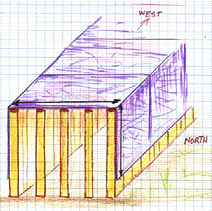 (2) The length of each curtain shall be twenty-eight cubits, and the width of each curtain four cubits; all the curtains shall have the same measurements. (3) Five curtains shall be joined to one another, and the other five curtains shall be joined to one another. (4) “You shall make loops of blue on the edge of the outermost curtain in the first set, and likewise you shall make them on the edge of the curtain that is outermost in the second set. (5) “You shall make fifty loops in the one curtain, and you shall make fifty loops on the edge of the curtain that is in the second set; the loops shall be opposite each other. (6) “You shall make fifty clasps of gold, and join the curtains to one another with the clasps so that the tabernacle will be a unit.
(2) The length of each curtain shall be twenty-eight cubits, and the width of each curtain four cubits; all the curtains shall have the same measurements. (3) Five curtains shall be joined to one another, and the other five curtains shall be joined to one another. (4) “You shall make loops of blue on the edge of the outermost curtain in the first set, and likewise you shall make them on the edge of the curtain that is outermost in the second set. (5) “You shall make fifty loops in the one curtain, and you shall make fifty loops on the edge of the curtain that is in the second set; the loops shall be opposite each other. (6) “You shall make fifty clasps of gold, and join the curtains to one another with the clasps so that the tabernacle will be a unit.
How big are each of the curtains? Answer
“The curtains were connected into two sets of five, by means not specified in the verbal description given here–probably by sewing.” -Douglas K. Stuart
What is the significance of making the curtains out of joined panels? “just one curtain sixty by forty-two would be much too large to try to move. So it’s clipped together in the middle, so that they can take it apart and then move on with it when God indicated that it was time to move. Everything was portable.” -Chuck Smith
What are the loops and clasps for? Answer
clasps –
Exo 26:6 And thou shalt make fifty taches of gold,…. Which some render “buttons” (i), others “hooks” (k) they seem to be “clasps” -Gill
How are the curtains joined together? Answer
“With ten curtains – Rather, of ten breadths. Five of these breadths were united so as to form what, in common usage, we should call a large curtain Exo_26:3. The two curtains thus formed were coupled together by the loops and taches to make the entire tabernacle-cloth Exo_26:6.” -Barnes
Implication of size/scale: A fine workmanship is required. Look at Isaiah about God’s workmanship:
Isa 40:22 It is He who sits above the circle of the earth, And its inhabitants are like grasshoppers, Who stretches out the heavens like a curtain And spreads them out like a tent to dwell in.
How do the curtains fit in comparison to the size of the tabernacle? Presuming we estimate the width of the tabernacle as 10 cubits, which is a fairly standard estimate (other estimates range from 9-12 cubits), this curtain would hang one cubit from the ground on either side, enough to keep the linen curtain well out of any mud or dirt on the ground (not that the desert was probably super-muddy or anything, it was a desert and all…).
“Based on the wording of these verses, it is fairly certain that the curtains lay in the opposite plane to that of the length of the tabernacle. In other words, since the front of the tabernacle faced east and its back was to the west, the curtains were draped from the south side to the north side (thinking of dramping them ‘left’ to ‘right’ as one faced the front of the tabernacle).” -Douglas K. Stuart
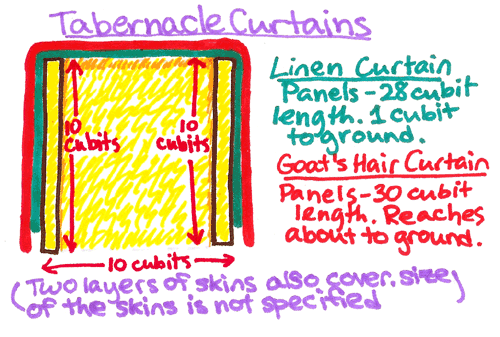
Significance of having 50 taches/buckles?
“[1]. FIFTY – The number of Pentecost (Lev. 23:15, 16; Acts 2:1). [2]. The fifty loops rested over the golden fillet that held the Veil, and we can see the Holy Spirit descending upon and filling the disciples (pillars).” –Dr. James Modlish
- On the 50th day after leaving Egypt, God met Israel at Sinai
- Deliverance – year of jubilee = 50th year, when property & liberty were restored
- Noah’s ark (instrument of salvation) was 50 cubits high
- The Feast of Pentecost (AKA Feast of Weeks, Feast of the Harvest, Shavuot), one of the “big three” feasts, was celebrated annually 50 days after passover, a celebration of thanks and blessing.
- The Holy Spirit was given during the Feast of Pentecost in Acts 2
Significance of these taches/buckles being made out of gold? Answer
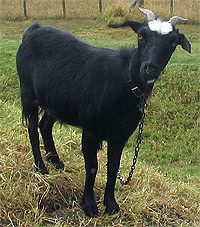 (7) “Then you shall make curtains of goats’ hair for a tent over the tabernacle; you shall make eleven curtains in all. (8) “The length of each curtain shall be thirty cubits, and the width of each curtain four cubits; the eleven curtains shall have the same measurements. (9) “You shall join five curtains by themselves and the other six curtains by themselves, and you shall double over the sixth curtain at the front of the tent. (10) “You shall make fifty loops on the edge of the curtain that is outermost in the first set, and fifty loops on the edge of the curtain that is outermost in the second set. (11) “You shall make fifty clasps of bronze, and you shall put the clasps into the loops and join the tent together so that it will be a unit.
(7) “Then you shall make curtains of goats’ hair for a tent over the tabernacle; you shall make eleven curtains in all. (8) “The length of each curtain shall be thirty cubits, and the width of each curtain four cubits; the eleven curtains shall have the same measurements. (9) “You shall join five curtains by themselves and the other six curtains by themselves, and you shall double over the sixth curtain at the front of the tent. (10) “You shall make fifty loops on the edge of the curtain that is outermost in the first set, and fifty loops on the edge of the curtain that is outermost in the second set. (11) “You shall make fifty clasps of bronze, and you shall put the clasps into the loops and join the tent together so that it will be a unit.
The Goat’s Hair Curtain
Bedouins (nomadic groups of desert-dwellers in areas such as Sinai and the Negev) tradionally have lived in tents covered in fabric woven with black goat’s hair. Could there be a relation between this traditional material and what was commanded for use in this protective layer over the tabernacle?

Bedouin Tent With Covering Made of Goat’s Hair
 What are the properties of goat’s hair? Wool fabrics come from a variety of animal hairs including the hair of goats. Maybe you are familiar with cashmere, or mohair fabrics, two well known types of wool fabrics made from goat’s hair? Some properties of wool: “The outside surface of the fiber consists of a series of serrated scales which overlap each other much like the scales of a fish. Wool is the only fiber with such serration’s which make it possible for the fibers to cling together and produce felt…Wool will not only return to its original position after being stretched or creased, it will absorb up to 30% of its weight in moisture without feeling damp…Wool is also dirt resistant, flame resistant, and, in many weaves, resists wear and tearing.” (Fabrics.com)
What are the properties of goat’s hair? Wool fabrics come from a variety of animal hairs including the hair of goats. Maybe you are familiar with cashmere, or mohair fabrics, two well known types of wool fabrics made from goat’s hair? Some properties of wool: “The outside surface of the fiber consists of a series of serrated scales which overlap each other much like the scales of a fish. Wool is the only fiber with such serration’s which make it possible for the fibers to cling together and produce felt…Wool will not only return to its original position after being stretched or creased, it will absorb up to 30% of its weight in moisture without feeling damp…Wool is also dirt resistant, flame resistant, and, in many weaves, resists wear and tearing.” (Fabrics.com)
What associations do goats typically have in the bible? Goats in the bible are also associated with the sin offering–not only the personal sin offering, but also for the annual sin offering on the day of atonement, two goats were used, one slain, the other led away. (Today in the new testament, Christ is our sin offering, he that had no sin was made sin for us (2 Cor 5:21). According to The Bible Study Page, Palestinian goats were black (note also Gen. 30 mentions goats and lambs and sheep from black and spotted and speckled flocks that were part of Jacob’s wages), and black is a color, that in the bible is symbolically associated with the blackness of sin.
How is this curtain different than the previous layer of curtains? Aside from being 2 cubits larger and completely covering the other curtain, while the first curtain was embroidered with fancy needlework that gives it more of an ornamental or decorative property, this one appears to be more of a practical protective layer, not pretty to look at, but quite useful.
Perhaps also the curtains not being identical sizes helps prevent the seams between panels from lining up and creating gaps, by having the panels different sizes, the positions of the clasps where the panels are joined are staggered.
| Linen Curtain | Goat Hair Curtain | |
| Made up of __ joined panels | 10 | 11 |
| Panels joined into two sections of ________ | 5 panels each | Five panels and six panels (the ends of the six paneled sections were doubled together giving extra strength to the structure) |
| Length | 28 cubits | 30 cubits |
| Width | 40 Cubits | 40 cubits (but required 44 cubits of material) |
| Taches (Buckles) | Gold | Brass |
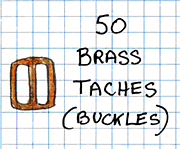 What is the significance of these buckles being brass unlike the linen curtain’s gold buckles? Answer
What is the significance of these buckles being brass unlike the linen curtain’s gold buckles? Answer
“Because the same hebrew word can designate either bronze (a copper and tin alloy) or copper, it is not always possible to know whether something like the clasps for the second layer of (goat hair) curtains of the tabernacle were actually bronze. or simply copper. Because Egyptian technology (which the Israelites had recently become familiar with) was as advanced as that of any other place, and because bronze production had begun fully long before the time of Moses, and in light of the desire for the tabernacle to be as ornate as possible, it is likely that the tabernacle metals…were really bronze, not merely the simpler and less durable copper” -Douglas K. Stuart
How far apart are the loops & buckles if there are 50 on one edge? Presuming a 20.5″ cubit, each 30 cubit panel is about 51′ long. This would mean there is a loop about every foot. And even if you presume an 18″ cubit or 22″ cubit, the total length would be in the range of 45-55′ long, meaning loops spaced at 10-13″ apart.
(12) “The overlapping part that is left over in the curtains of the tent, the half curtain that is left over, shall lap over the back of the tabernacle. (13) “The cubit on one side and the cubit on the other, of what is left over in the length of the curtains of the tent, shall lap over the sides of the tabernacle on one side and on the other, to cover it.
(14) “You shall make a covering for the tent of rams’ skins dyed red and a covering of porpoise skins above.
Rams Skin Covering
“The third layer was made of ‘rams skins dyed red’ (NIV, HCSB) or simply “tanned rams’ skins” (NRSV). The latter may be the more likely translation since the tanning process gives a reddish-brown hue to rams skins, and it is the tanned nature of those skins (pliable, soft, thick, protective without being bumpy) and not their color that is the focus of this description.” -Doublgas K. Stuart
“Now this is for waterproof, this is the outer covering and it’s the waterproof.” -Chuck Smith
26:14 The third covering was made of rams’ skins, and the fourth was made of badger skins (also translated seal, porpoise, or dolphin skins). No measurements are given; these coverings were probably the same size as the goats’ hair covering. -BBC
“Rams died red – suffering. Ram – Gen 22 – Abe Isaac – showed Ram. Same hill – God will provide himself. year of Jubilee Ram’s horn. Ram’s skin -God’s grace” -Calvary Vista
badger skin (porpoise skin) – this is the part that is seen (the outward form). Its not eye catching like the finely woven linen. Its ordinary.
Sea Cow Covering
“The fourth, or outer layer was made from the ‘hides of sea cows’ (HCSB ‘manatee skins,’ NRSV ‘fine leather,’ NJPS ‘dolphin skins’). The final layer was the one people would see most of the time, the layer exposed to the weather. The thick durable leather hides of sea cows would protect from the hot sun, rain, snow, dew, frost, dust, and sand and would withstand setup and teardown repeatedly as the Israelites moved from place to place” -Douglas K.Stuart
“The inner, bottom covering was to be rams’ skins dyed red. What the outer covering was is subject to mystery. The Hebrew word, “TACH-ash” is rendered in the NAS “porpoise skins,” in the NIV as “hides of sea cows,” and in the King James as “badgers’ skins.” Many commentators conclude that what is meant here is “seal skins.” Whatever it was, it appears that this outer covering was used as a rain repellent – a waterproof cover.” -Ron Daniels
Walls 26:15-30
“Everything in the tabernacle speaks of either the person or work of Christ. Every covering, every thread, and every article of furniture reveals some facet of the Savior. As the bars held the tabernacle together, so the Holy Spirit of God holds true believers together today. Believers should be held together by the Spirit. In fact, believers are told “to keep the unity of the Spirit in the bond of peace.” -J. Vernon McGee
Boards 26:15-25
The walls of the tabernacle are to be made out of boards of acacia wood (26:15) overlaid with gold again (26:29).
(Note that from the information in this segment, the dimensions of the Holy of Holies is 10 x 10 x 10 cubits, a perfect cube…the same proportions as the new Jerusalem in Revelation 21:16)
“ While standing in the holy place everything not visible below ground level was of silver and everything that could be seen above the ground was golden even though the framework was acacia wood overlaid with gold.”
 “(Ex. 26:15) Then you shall make the boards for the tabernacle of acacia wood, standing upright. (16) Ten cubits shall be the length of each board and one and a half cubits the width of each board. (17) There shall be two tenons for each board, fitted to one another; thus you shall do for all the boards of the tabernacle.”
“(Ex. 26:15) Then you shall make the boards for the tabernacle of acacia wood, standing upright. (16) Ten cubits shall be the length of each board and one and a half cubits the width of each board. (17) There shall be two tenons for each board, fitted to one another; thus you shall do for all the boards of the tabernacle.”
Some interpret the boards as “frames” a constructed shape rather than solid boards.
What is the significance of using boards for the walls of the tabernacle (tent)? “These boards were better than ‘tent poles’, they actually form a solid room inside the tabernacle” (Calvary Fullerton: Sunday Evening Bible Study, May 4, 1997) “Curtains without boards would have been shaken by every wind” (Matthew Henry).
What is the significance of the boards being made of acacia wood? Its a nearly indestructable hardwood as previously mentioned (see section on ark of the covenant), built to last.
How big is each board? Each board was to be 10 cubits tall and 1.5 cubits wide (26:16). Thickness is not specified. Assuming a 20.5” cubit (for reasons previously stated), these boards are each about 17 feet tall, and 2.5 feet wide. Interesting factoid: According to US National Center for Health Statistics, the average male height is 5’9″, making the tabernacle almost exactly three times the height of a man.
Rav Meir Spiegelman, a Jewish Rabbi, is of the opinion that because the torah makes no mention of the boards thickness, we should conclude that their measurement is of ‘no significance’. He also feels that “The importance of the Mishkan is inward rather than outward, and therefore only its internal measurements are noted” Alan Hugh McNeile says that the hebrew word used for boards could refer to panels or planks, but not large solid beams, ie: these are thin boards, not hefty beams
“At the time, there must have been an abundance of acacia trees in the desert. There would need to be. [description of size of one board] One assumes that each board was cut into one length, without any joins in it. So each board was probably cut from the central trunk of the tree. How tall is the trunk of the tree before it breaks into spreading branches? If the boards could not be cut out of one piece of timber, then the wide planks would need to be joined or moulded together –hooper
1.5 cubit width – “This is an UNWHOLE and UNBALANCED number. So in the next verse the Lord says that this UNBALANCED board is to be linked together with another board that is a cubit and a half thus making 3 cubits making a whole number. The believer is NOT intended to live out his Christian experience ALONE – We are being FIT together Paul said. The PATTERN of the Tabernacle tells us that you should be LINKED to another believer, THAT is where strength is. IF I’m linked to someone I find that I come to a place of STABILITY in those UNSTABLE areas of my life” -Rob Salvato, Calvary Chapel Vista, Sermon
What is a tenon? How do the tenons attach?
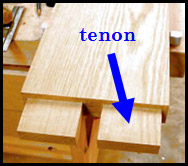 TEN’ON , n. [L. teneo, to hold.] In building and cabinet work, the end of a piece of timber, which is fitted to a mortise for insertion, or inserted, for fastening two pieces of timber together. (Websters)
TEN’ON , n. [L. teneo, to hold.] In building and cabinet work, the end of a piece of timber, which is fitted to a mortise for insertion, or inserted, for fastening two pieces of timber together. (Websters)
By using this type of connector, common in traditional Chinese architecture, the boards could interlock with perfect fit, without requiring glues or fasteners, and allows the wood to expand or contract according to humidity.
Tenon (in Hebrew: יד or yad) Strongs #3207 – Yad occurs 1536 times in the old testament, and only four of those times is it translated tenon, all four of those times being in the context of describing the tabernacle construction in Exodus 26 and 36. Most of the time, yad means hands, or the work of the hands. It also has many figurative uses, such as describing someone who would be a right-hand man (assistant) or in the hand of (in the custody of). The use of yad as tenon seems to be one of those figurative cases, as tenons are sort of like fingers. Learn more about tenons/yad (brief word study)
“(26:18) You shall make the boards for the tabernacle: twenty boards for the south side. (19) You shall make forty sockets of silver under the twenty boards, two sockets under one board for its two tenons and two sockets under another board for its two tenons; (20) and for the second side of the tabernacle, on the north side, twenty boards, (21) and their forty sockets of silver; two sockets under one board and two sockets under another board.
How large is the south side of the tabernacle? Is the north side the same size? 20 boards of 1.5 cubits each totals 30 cubits in length, and each board is 10 cubits in height. Using the 20.5″ cubit, the south and north wall are each about 51′ long and 17′ tall.
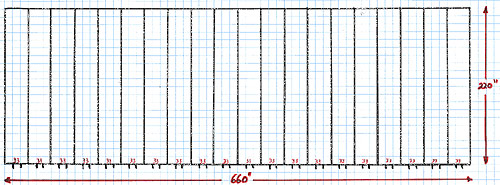
Barry Hooper’s Illustration of the South & North Wall Boards (22″ Cubit)
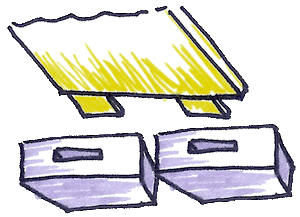
What is a socket? More than just meaning a slot something can be inserted into (like an electical socket), the word translated into english as socket, אדן or ’eden, also implies a foundation of a building or column. Is closely related to another hebrew word meaning firm or strong. Lacking the foundation of sockets, the tabernacle would be weaker and not as sturdy.
Why use sockets for the foundation? Since the tabernacle is designed to be a portable structure, the foundation needs to be able to be transported and reassmbled. Using a modular design where the foundation is broken into a set of 100 sockets (Ex. 28:37), rather than a continuous foundation, each socket is light enough to be carried by one or two strong men. Barnes points out that not only would the silver provide ornamentation value, it would also prevent the wood from decaying as it sits on the damp ground.
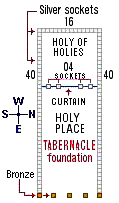 How much silver went into each socket? Each socket is made of one talent of silver (38:27) which was accumulated from the numbering of the congregation (38:25). One talent of silver is a significant amount. A talent was the largest named unit of weight measure in ancient Israel. One talent of silver was considered the value of a human life, the redemption price to save someone’s life who was guilty of an offense punishable by death.
How much silver went into each socket? Each socket is made of one talent of silver (38:27) which was accumulated from the numbering of the congregation (38:25). One talent of silver is a significant amount. A talent was the largest named unit of weight measure in ancient Israel. One talent of silver was considered the value of a human life, the redemption price to save someone’s life who was guilty of an offense punishable by death.
What kind of size and weight are we talking? As far as weight, it would be somewhere in the range of 50-100 lbs. See sidebar: How Much is a Talent? Because we know the density of silver (10.5 g/cm3), we can calculate volume from the weight. The volume of silver, per socket, would be somewhere in the range of 131-263 cubic inches. If each socket is 15 inches long (approx. half the width of a single board) and 4 inches tall, would be about 2.2 – 4.4 inches wide.
However, the shape and dimensions of the sockets are not specified, so we don’t have any certain way of knowing whether they were cubic blocks, cylinders, or rectangular, or an elaborate shape, though it is a common opinion among commentators that the sockets formed a continuous foundation. However, we can rest assured that since Moses had a vision of what the tabernacle should look like, he was able to communicate to the craftsmen additional details about the construction not mentioned in the bible.
What parts of the tabernacle are silver? Is there a significance to which components are silver? Only the components below ground, the foundation stones for the sanctuary and veil, are made out of silver. Everything above ground is covered in or made of gold (or in the courtyard, bronze). It is an interesting contrast that the sockets for the curtain to the holy place and the outer courtyard are made out of bronze.
Are there any important spiritual or new testament parallels?
“Silver in the Old Testament is equivalent to blood, it is the blood money used for redemption (a ransom money paid to God). It was this silver that was brought together to make the foundation of the Tabernacle. Silver Levitically speaks of blood, Matt 27:3-4. Thus, everything in the entire Tabernacle sat on silver sockets; 1 Cor 3:11, the entire structure rests upon the blood of Jesus Christ. Every detail points to the cross!” -Chuck Missler
The foundation would be buried in earth, it would not be visible to human eyes.
Spiritual parallel: Man is not able to see the full value of redemption.
“In the new covenant Paul the apostle says that like an expert builder he was laying a foundation. Then he adds that the foundation is not a system of beliefs but a person: 1 Cor 3:11 For no other foundation can anyone lay than that which is laid, which is Jesus Christ.” -bible-history.com
“(22) For the rear of the tabernacle, to the west, you shall make six boards. (23) You shall make two boards for the corners of the tabernacle at the rear. (24) They shall be double beneath, and together they shall be complete to its top to the first ring; thus it shall be with both of them: they shall form the two corners. (25) There shall be eight boards with their sockets of silver, sixteen sockets; two sockets under one board and two sockets under another board.
What is the ratio of width to length of the tabernacle structure? Not counting the added length or width from the corner boards, it would be approximately 6:20, or 3:10, the same proportions as two 3:5 index cards laid end to end. Addition of the corner boards, depending on how you attach the, could change the ratio to be closer to 2:5 (or 4:10)
How are the corners laid out? … This is difficult to understand, and glossed over in pretty much every commentary I’ve read.
Each corner board is made up of two boards, providing either a double thickness or custom shape. However, each doubled board still only get two tenons. How exactly the corner boards attach to the other boards is less clear.

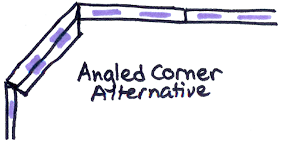
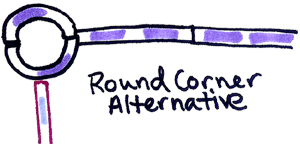
Round boards –
A few possibilities of size if full-sized boards are used for the corner boards:
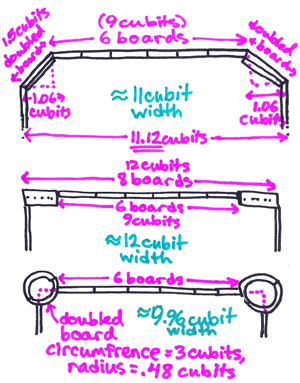
Why were there extra boards in the corners? “…that the corners might be thicker and stronger, and so for the greater firmness of the building” (Gill)
Explain verses 23-24?????
How are the sockets arranged on this wall? Same as on the others, one socket under each tenon.
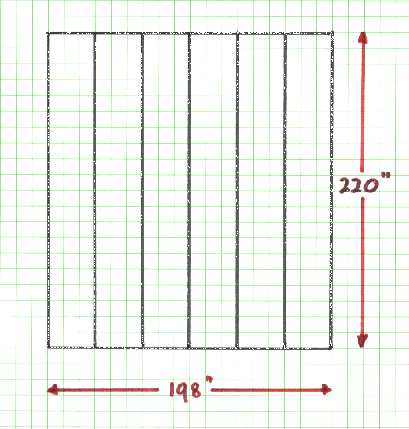
West Wall (Hooper)
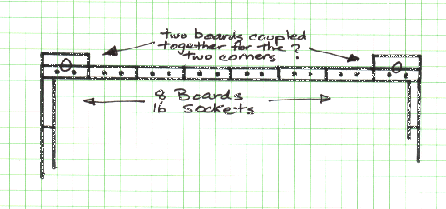
Hooper’s illustration of one way the corners could have been anchored
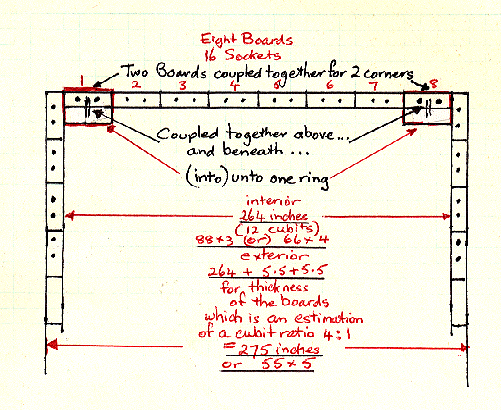
Hooper’s illustration of another way it could have been anchored.
Bars 26:26-30
“(26) Then you shall make bars of acacia wood, five for the boards of one side of the tabernacle, (27) and five bars for the boards of the other side of the tabernacle, and five bars for the boards of the side of the tabernacle for the rear side to the west. (28) The middle bar in the center of the boards shall pass through from end to end.”
“The boards were kept in place by wooden bars, covered with gold, that passed through gold rings on the boards. The middle bar was one continuous piece. Two shorter bars of varying lengths may have been joined together to form one bar at the top, and two others joined to form one bar at the bottom. Some think that the boards were trellised frames.” -BBC
What are the bars for?
????
“Then they were to make these silver sockets and these boards were to be sort of tongue and groove, fitting together, fitting in the silver sockets in the bottom. Then with the rings in the sides so that they could set the boards up and then run a stave through the ring so that the boards would stand upright.” -Chuck Smith
Douglas K. Stuart writes that the crossbars may have actually been roof supports, and that ‘five for teh frames on one side’ may not refer to placement, but symmetry of the overall count, one approximately every two cubits, with a long one cross-wise, a center “ridge-pole”.
“The principle of cross bracing on modern floor and ceiling joists is exactly the same, and the added rigidity is remarkable since the cross braces do not merely link one joist to another, but all joists to all other joists, so as to make a unit out of what would otherwise be essentially independent timbers…What is important to note theologically here is that the cross bracing was simply a contruction technique and has no symbolic meaning of any kind. The lightweight frame of the tabernacle made it portable, and it was its portability that was symbolic, ie of Yahweh’s traveling with his people–not unlike the indwelling of the Spirit in the New Covenant…” -Douglas K. Stuart
The boards that made up the tabernacle walls appear from these verses to have cross-bars to strengthen the structure.
Exodus 16:26-30 parallels Exodus 36:31-34, where the work of making the bars of the tabernacle was already completed.
| (One Side) South Side | 5 Bars |
| (Other Side) North Side | 5 Bars |
| (Rear) West Side | 5 Bars |
| Total | 15 Bars |
“The frames were also secured by a series of 15 crossbars (5 on each of the two sides and 5 at the back) that fit through gold rings horizontally (Exo_26:26-30). These bars were to be overlaid with gold. The center bar on each side was to extend the full length; apparently the other bars were shorter.” -BKC
Bar – “The Hebrew word used for “bar” in this context, is “beriah” or “beriach” from “barah” meaning “to pass” or “shoot”. The meaning for this word in its context is given in Young’s Analytical Concordance as “Flying, or piercing object, bar”. It may be that the middle bar was actually inserted through the thickness of the boards, in which case those centre bars would not be visible from either inside, or outside the tabernacle.” –hooper
“The middle bar, halfway up the frames, shall run from end to end.” (26:28 ESV)
Bars – בּריח or beriyach – typically, a wooden bar, or the bars on city gates. The implication appears to be a horizontal strengthening cross-piece.
“how long these bars were it is not said, but it is reasonable to conclude that they reached the length of the tabernacle, which was thirty cubits; and as it was not easy to get bars of such a length, the notion of Josephus (u) perhaps, may be right, that each two consisted of diverse parts which joined one another, the head of one entering into the hollow of the other and as he supposes they were five cubits long, a row of them must have six parts, which went along the sides, north and south, and the west end two, which was but ten cubits” -Gill
“We read… that the centre bar around the walls of the Tabernacle, was continuous along each of the three sides of the Tabernacle. …The rods or bars themselves would need to be straight. … Again, highly skilled carpentry techniques would be required to make such long bars. –hooper
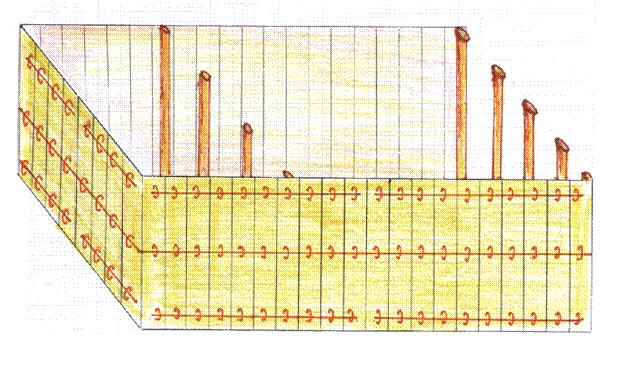 *image not to scale
*image not to scale
|
South Side North Side West Side TOTAL |
20 x 3 = 60 Rings 20 x 3 = 60 Rings 8 x 3 = 24 Rings 144 Rings |
NOTE : If all bars are visible from inside or outside of tabernacle, then 48 boards x 3 rings = 144 rings, or If centre bars not visible from inside or outside of tabernacle, then 48 boards x 2 rings = 96 rings -Hooper
“(29) You shall overlay the boards with gold and make their rings of gold as holders for the bars; and you shall overlay the bars with gold.”
What are the properties of gold? Answer…
What are the rings for? Answer…
What parts of the tabernacle do we learn are covered in gold? Is there a significance to which parts are/are not covered in gold? Answer…
What is the significance of the boards, rings, and bars being covered in gold? Answer…
The Assembled Boards overlaid in gold, which make framework of the Tabernacle, looking from the east end towards the west end.
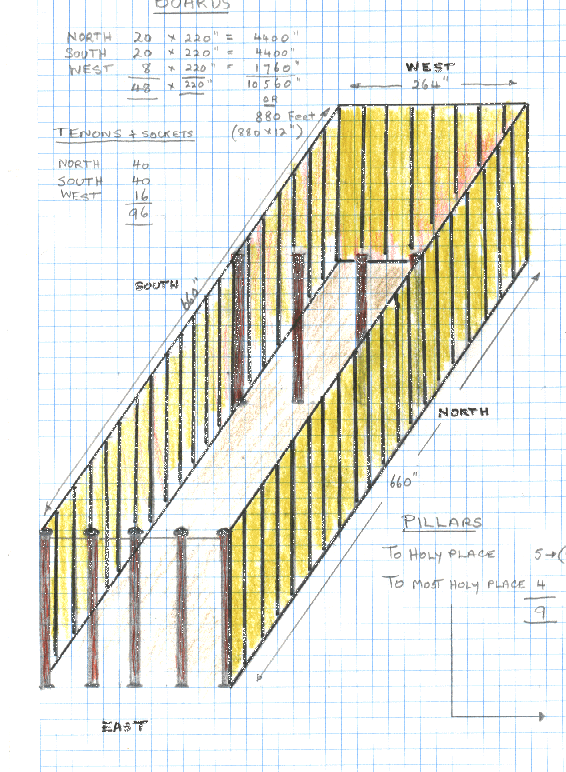
Hooper’s Sketch of Assembled Boards
“(30) Then you shall erect the tabernacle according to its plan which you have been shown in the mountain.”
What did God command them to do? Erect (build, put together, assemble) the tablernacle as shown.
“According to its pattern which you were shown on the mountain…the repetition of this phrase (25:9; 25:40; and here in 26:30) suggests that Moses was actually given a vision of exactly how the tabernacle should look – a vision he would have to communicate to the craftsmen who would do the actual building.” (Guzik)
“Moses did not just hear words. He saw pictures. The words he heard from Yawweh…are what we find in the text of Exodus as it describes the tabernacle design. But Moses actually saw what we might call the ‘blueprints’ as well. Then when he came back from the mountain and passed on God’s instructions to Bezalel, Oholiab, and their coworkers, he not only told them what to make and how to make it, but he also knew how to recognize its finished look because he had been shown what the various tabernacle components were to look like. The partial information provided in the written text represented no problem to them, even though it can be confusing in places to us, because Moses had seen a visual supplementation of the spoken words and knew exactly what Yaheweh wanted for his house.” -Douglas K. Stuart
“These instructions give us a fair idea what the tabernacle looked like, but they do not answer all of our questions. Anyone who has ever compared pictures of the tabernacle knows that no two drawings are ever quite the same…Moses is the only person who ever saw the original model…Presumably what God showed his prophet was this prototype for the tabernacle, and seeing it helped him make sense of all the instructions.” -Philim Graham Ryken
“God works the same way in leaders today; giving them a vision of what His work should be, and having those with the vision pass it on to others who will do much of the actual work. Moses couldn’t have remained silent about what God had shown him, or the work would never have gotten done!” (Guzik)
Douglas K. Stuart on the plans they’d been shown:
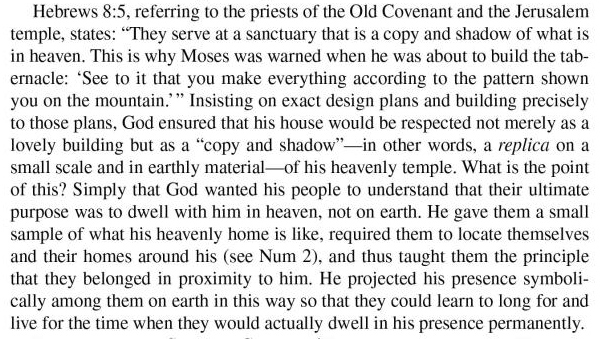
Veils 26:31-37
(31) “You shall make a veil of blue and purple and scarlet material and fine twisted linen; it shall be made with cherubim, the work of a skillful workman. (32) “You shall hang it on four pillars of acacia overlaid with gold, their hooks also being of gold, on four sockets of silver. (33) “You shall hang up the veil under the clasps, and shall bring in the ark of the testimony there within the veil; and the veil shall serve for you as a partition between the holy place and the holy of holies. (34) “You shall put the mercy seat on the ark of the testimony in the holy of holies. (35) “You shall set the table outside the veil, and the lampstand opposite the table on the side of the tabernacle toward the south; and you shall put the table on the north side. (36) “You shall make a screen for the doorway of the tent of blue and purple and scarlet material and fine twisted linen, the work of a weaver. (37) “You shall make five pillars of acacia for the screen and overlay them with gold, their hooks also being of gold; and you shall cast five sockets of bronze for them.
“The curtain that closed off the most holy place (‘Holy of Holies’) from the front room of the tabernacle (the ‘Holy Place’) was manufactured to match the curtains that lined the inside fo the tabernacle (26:1) and the entrace curtain (26:36), so that everything in the interior of the tabernacle shared the same general appearance of blue, purple, and scarlet yarn and finely twisted linen curtains with cherubim motifs worked into them, supported by gilded frames and poles with silver bases” -Douglas K. Stuart
“The special vailing curtain…was one long, single curtain, not a divided curtain that could be opened easily…it was not designed to be gotten past under normal conditions; rather, it provided a barrier past which people could not normally go” -Douglas K. Stuart
“There was blue, a heavenly color. There was scarlet, which speaks of Christ’s blood. There was a blending of the blue and scarlet which produced a purple color that speaks of royalty. The blue and scarlet speak of heaven touching earth, or the humanity of Christ. The purple speaks of Him as King of the Jews.” -J. Vernon McGee
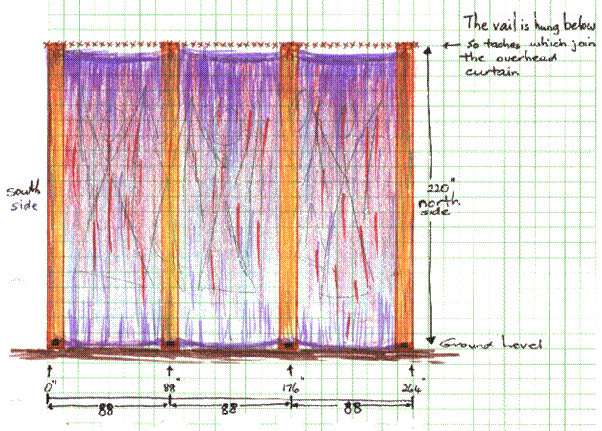
Veil Drawing: Hooper
Veils vs. Curtains vs. Screens?
In English we have somewhat similar words for describing curtain-like objects:
veil (n.) – something that covers, separates, screens, or conceals.
screen (n.) – a movable device designed to divide, conceal, or protect.
curtain (n.) – something that functions as or resembles a screen, cover, or barrier
How they are translated by various translations is as follows:
| Hebrew Strongs |
KJV | NASB NKJV |
NIV | ASV ESV |
|
|
VEIL |
poreketh ( פּרכת ) (po-reh’-keth) #6532 |
veil | veil |
curtain, |
veil |
|
SCREEN |
masak ( מסך ) (maw-sawk’) #4539 |
hanging, covering, curtain |
screen, veil |
curtain |
screen, covering |
|
CURTAIN |
yeriyah ( יריעה ) (yer-ee-aw’) #3407 |
curtain |
curtain |
curtain |
curtain |
|
HANGINGS |
qela ( קלע ) (keh-lah) #7049 |
hangings, (sling) |
hangings, (sling) |
curtains, (sling) |
hangings, (sling) |
A few things are clearly apparent from this chart: yeriyah ( יריעה ) means curtain. NIV simplifies and makes the vocabulary consistent by making all of these words into the word curtain. Qela ( קלע )has two meanings, one as a hanging or curtain, and one relating to slingshots; only the one translated hangings is related to the context in concern. ASV and ESV appear to do the best job of differentiating the underlying Hebrew word. NKJV and NASB do almost as well, with the single exception of Exodus Chapter 40.
In Chapter 40, in these two translations the word veil appears six times in three contexts:
- Veil Screening the Ark of the Covenant (Ex 40:3,21) poreketh ( פּרכת ) veil
- Veil for the Doorway to the Tabernacle (Ex 40:5,28) masak ( מסך ) screen
- Veil for the Gateway of the Court (Ex 40:8,33) masak ( מסך ) screen
It seems as though there is some sort of differentiation between the first veil and the other two veils. The first veil is the one blocking view of the Holy of Holies. The other two block view of the Holy Place and the Courtyard of the Tabernacle respectively. Throughout the text in Exodus, this terminology in Hebrew is consistent. On the surface, yes, all three of these are curtains or veils, however you want to picture it, and the word screen may in fact be confusing based on its common English use as a portable wall rather than curtain, but underlying there is some sort of fundamental difference between the one covering the Holy of Holies.
Other types/uses of veils:
- Cultural – Veils are used to cover the face of a bride during a wedding ceremony.
- Biblical – Moses put a veil, masveh (מסוה), over his face after it was glowing/shining from Sinai except when he was speaking to the Lord Ex 34:33
Vail – Literally, separation -Barnes
Things to think about?
- – shape of pillars not specified…Round? Square?
- -no width measurement given for pillars
- – did veil have any allowance for gathers or pleats? (probably not)
“The description of the horizontal cross-bars is relatively laconic. We do not know if they were single poles or more elaborate structures” – Douglas Stuart (The New American Commentary)
The door (26:36-37) – “[1]. Colors same as the Gate, hanging on FIVE PILLARS (shittim wood overlaid with gold, with brass sockets and gold chapiters). [2]. The Gate is WIDE (5 cubits by 20 cubits) – “Whosoever will may come”. [3]. The door is NOT SO WIDE (10 cubits square) – The way of salvation is wide, but the door to close fellowship is narrow (higher) and nearer to God (the high and Holy character of God).” –Dr. James Modlish
“FOUR PILLARS – The four gospel writers: MATTHEW, MARK, LUKE, AND JOHN. Five on the Door, N.T. writers: Paul, James, John, Peter, Jude.” –Dr. James Modlish
“The Old Tabernacle had a curtain that separated the Holy Place from the Most Holy Place. This was literally torn in half and thus removed when Christ died. “The curtain of the temple was torn in two from top to bottom.” Mark 15:38 The curtain may be likened to the physical body of Christ, which having been torn apart on the cross opened for us a way to have access to God. “Therefore, brothers, since we have confidence to enter the Most Holy Place by the blood of Jesus, by a new and living way opened for us through the curtain, that is, his body” Heb 10:19,20” – Boston Christian Bible Study Resources
Hooper on the Veil:
“The families of Levi’s son Gershon are in charge of making and assembling the curtains, furniture coverings, and veils.”
“The Priests were allowed to enter the Holy Place, but were not to go beyond the four pillars which held up the veil to hide the Most Holy Place. Only the High Priest was to enter there.
“The four sockets of silver into which the four vail hooks were firmly entrenched would remind the priests of the “redemption money” and all that it represented, which was collected at the numbering of the Israelites
“Before the Fall, Adam could speak to God in the “Garden” – he walked and talked with God. Since the Fall of Adam, that is when he disobeyed the laws of God, man could not approach God. When Moses built the tabernacle, God told Moses that he would communicate to the nation from within the Most Holy Place of the Tabernacle. The veil separated man from God. The veil hid from man the presence of God in the Tabernacle. God’s Glory is too powerful for man’s physical being to look upon or withstand.
only priests allowed to enter the tabernacle, not members of the congregation
The tabernacle had a curtain separating the Holy Place from the Most Holy Place. We know from Mark 15:38, the curtain (in the temple, which later replaced the tabernacle) was torn in two from top to bottom, opening up access to God directly. Hebrews 10:20 clearly shows the curtain is symbolic of Christ’s body.
Pillars to the Holy Place
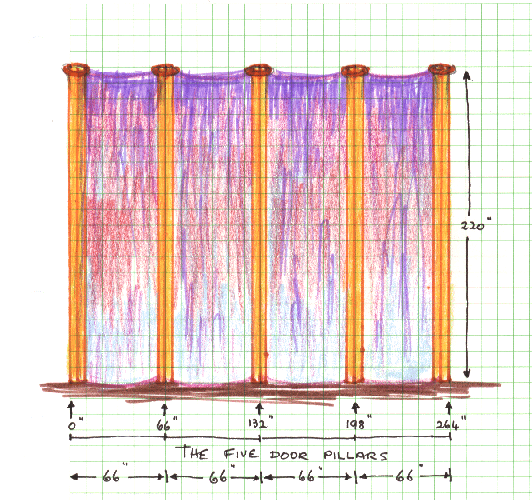
“The brass sockets in the five door pillars, represent the judgment of man because of sin and disobedience to God. In Deuteronomy 28.23, God told the nation that if they were disobedient He would make the heavens as brass over them.” -Hooper
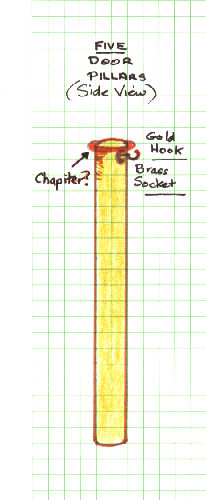
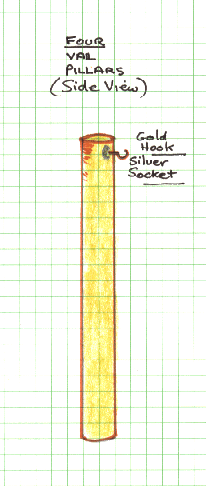
| Between Holy of Holiesand the Holy Place | Between the Holy Placeand Outer Courtyard | |
| Hanging from the Pillars was a: | Veil | Curtain |
| Pillars: | 4 pillars | 5 pillars |
| For the gold veil/curtain hooks: | 4 sockets of silver | 5 sockets of brass |
| Pillars made of shittim wood overlaid with gold | Yes | Yes |
| Described as having Chapiters and Fillets | No | Yes |
| Described as having Cherubim (woven?) in the veil/curtain | Yes | No |
“ The Hebrew word used for “chapiters” is “rosh”, meaning “tops” or “heads” of the pillars. The Hebrew word for “fillets” is “chashugim”, meaning “fastenings”. Therefore it is not clear as to whether or not any of the pillars had decorative tops or bottoms. The “fillets” could have been the fastenings or sockets for the hooks. -Hooper
“The stabilising role of the pillars in the Tabernacle structure is vital” – Hooper
“When the curtains are completed, they will tie two sections together with “taches”, and the four vail pillars will be placed under these taches to divide the Tabernacle into two rooms” -Hooper
Note that in verse 37, it says the pillars will be overlaid in gold, however, Exodus 36:38 says only that the tops and bands were overlaid in gold. “…he made its five pillars with their hooks, and he overlaid their tops and their bands with gold; but their five sockets were of bronze” Does this mean that only the top parts of the pillar are overlaid in gold? Or by ‘top’ does he mean everything above the sockets?
More pillar differences: these 5 pillars on the outside, unlike the 4 pillars on the inside have bronze sockets rather than silver sockets.
